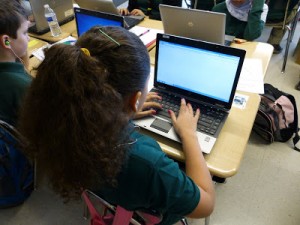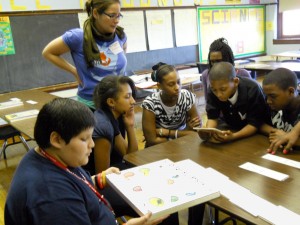Sources of urban EE are diverse, but partnerships can align the goals of different organizations to empower students.

Middle schoolers at Van Nest Academy carry out student-led experiments on water quality in small groups. Photo courtesy of insideschools.org.
In the East Bronx, a 20 minute walk from the Bronx River, students at Van Nest Academy public middle school practice “student-led investigation” as they design and carry out scientific research on water quality.
“There’s some kids that really thrive outside,” said 7th grade science teacher Boris Lazarev. “When they get outside and they’re doing hands-on stuff, they’re really enlivened.”
Lazarev is not the first teacher to see a change in students when they get involved in local nature. In the last decade, studies have shown that outdoor activities like environmental education (EE) decrease ADHD symptoms, serve as a stress buffer, and improve self-esteem and mood. In a 1997-2003 Washington State study, students at schools that prioritized environmental science performed consistently better on standardized tests for math and English than students at schools without an environmental focus.
But Lazarev doesn’t define his work in class solely as EE. Primarily, he teaches science. “The goal is for them to get more critical thinking skills,” he said.
Van Nest Academy’s partner organization for its science program, Urban Advantage, is focused more on science education than on the environment specifically. Urban Advantage is an NYC initiative in which organizations like the Bronx Zoo, the New York Aquarium, and the American Museum of Natural History partner with schools to connect urban students to the scientific resources in their communities. In the case of VNA, Urban Advantage provides professional development for teachers and materials for water testing.
Urban Advantage employs EE with the aim of creating “hands-on investigations that engage [students] in science as a way of thinking and investigating rather than simply as a body of knowledge,” according to its website.
VNA also partners with the Bronx River Alliance, an environmental organization committed to protecting and restoring the Bronx River as a resource for the communities around it. The Alliance works with VNA to get students out on the river and participating in much-needed water quality tests.
The Alliance’s Chief Educator Damian Griffin has yet another motivation for his EE work in the South Bronx—increasing young people’s comfort in their environment. Many South Bronx students are recent immigrants from more rural areas, he said. Griffin wants to help these young people access the nature in New York City: “It’s still here, you just have to push to find it.”
People and organizations who provide city students with environmental knowledge often describe their motivations outside the realm of EE. Some are invested in the broader concept of science education. Some want to connect students to their communities. Partnerships that pool resources can bring together organizations with different missions—but despite varying motivations, these collaborations help foster programs that encourage critical thinking, teach science, and involve students in their environments.
Connections between schools and other groups are vital in countering a lack of resources and support for EE in city schools. Teachers in a 2012 study of a Bronx after school program said there was not enough time or money for students to take field trips or teachers to incorporate environmental learning into the everyday curriculum.
And pushback from other departments can be a challenge. “A lot of math and English teachers don’t like kids to go out [on science field trips] because they don’t want to lose that time with them,” Lazarev said. “They have to cover a certain amount of material in a certain amount of time.”
The key at VNA, Lazarev said, is administrative support for the science program. “The principal encourages all these field trips—a lot of principals don’t want teachers to leave the building,” he explained.
Urban Advantage provides training and materials to make field trips valuable and garner in-school support for the VNA science program.
Looking Forward
Without the partnerships and administrative encouragement that bolster the VNA science program, many urban schools have little or no EE. Other serious urban issues, from violence to illiteracy, make it hard for teachers to see environmental work as a key part of the big picture.
Schools in cities struggle to bridge the opportunity gap, a disparity in resources available to minority urban students. Urban schools struggle with a ten percent higher illiteracy rate than other schools. Black, Hispanic, and Native American students drop out at rates twenty percent higher than white and Asian students.
But this wide range of problems can provide a range of motivations for incorporating EE into curricula.
In the mostly urban schools that struggle to make nationally required adequate yearly progress on state tests, the evidence that environmental science improves test scores may help make the case for EE.
School communities that face low student achievement and high truancy and drop-out rates may incorporate EE as a tool to build community responsibility. Many urban environmental programs aim to build environmental stewardship and foster students’ personal skills.
In another program at VNA, the seventh grade students involved in Green Team are developing leadership and community responsibility as they become a source of EE for other students. Seventh grader and team member Yosvanny described Green Team: “We’re a group of seven that’s joined into a team to help the school become green.”
On Monday, April 7th, the Green Team used its usual lunchtime meeting to finish preparing a slideshow that the team members would present that week to help their classmates participate in the recycling system.
Green Team members created descriptive labels for the recycling and trash bins, and they are planning to offer a prize to the class that recycles the most.
Asked what she learned from Green Team, student and team member Alicia answered, “How to work as a team and listen to everyone’s ideas and collaborate them.” Isaak, another member, agreed, “Making sure everybody’s talking, everybody’s included.”
The members of Green Team see themselves as leaders in the school community. Alicia said, “We know that we’re not going to be here next year, but we hope that from what we do now, when we leave next year, they will continue to do this program, because it will keep improving year by year.”
Action projects like Green Team help students develop a sense of efficacy that can empower them in other aspects of their lives. Yosvanny shared a story of effecting change: “I have a sister in the first grade. Before, she never used to recycle.” After Yosvanny presented to her class, he said, his sister started recycling at school and at home. “She’s telling me, ‘Yosvanny, where does this go?’ And I tell her, ‘You have to figure it out!’… Now she doesn’t need my help, she just does it by herself.”
Green Team’s aspirations extend well beyond the school. “Once a person gets green and they get addicted to it,” said Green Team member Daniel, “it’s something they just want to do. Soon the community goes green, the city goes green, the state goes green, and we become like Sweden where you just have to import garbage!”
The passion of students like these is contagious. But urban EE can span other passions too, from the VNA science program’s goals to develop critical thinking skills to Damian Griffin’s desire to help immigrant youngsters feel comfortable in their environments. By finding common ground and fostering support for partnerships, these diverse sources can expand EE into a reality for more and more urban students.
And the seventh graders on Green Team want to make sure environmental awareness keeps expanding. Alicia said Green Team talks to elementary school students about recycling in their own communities. “It all starts with you,” she said she tells the younger students. “You get your own bins, make signs, and start communicating with your neighbors.”


